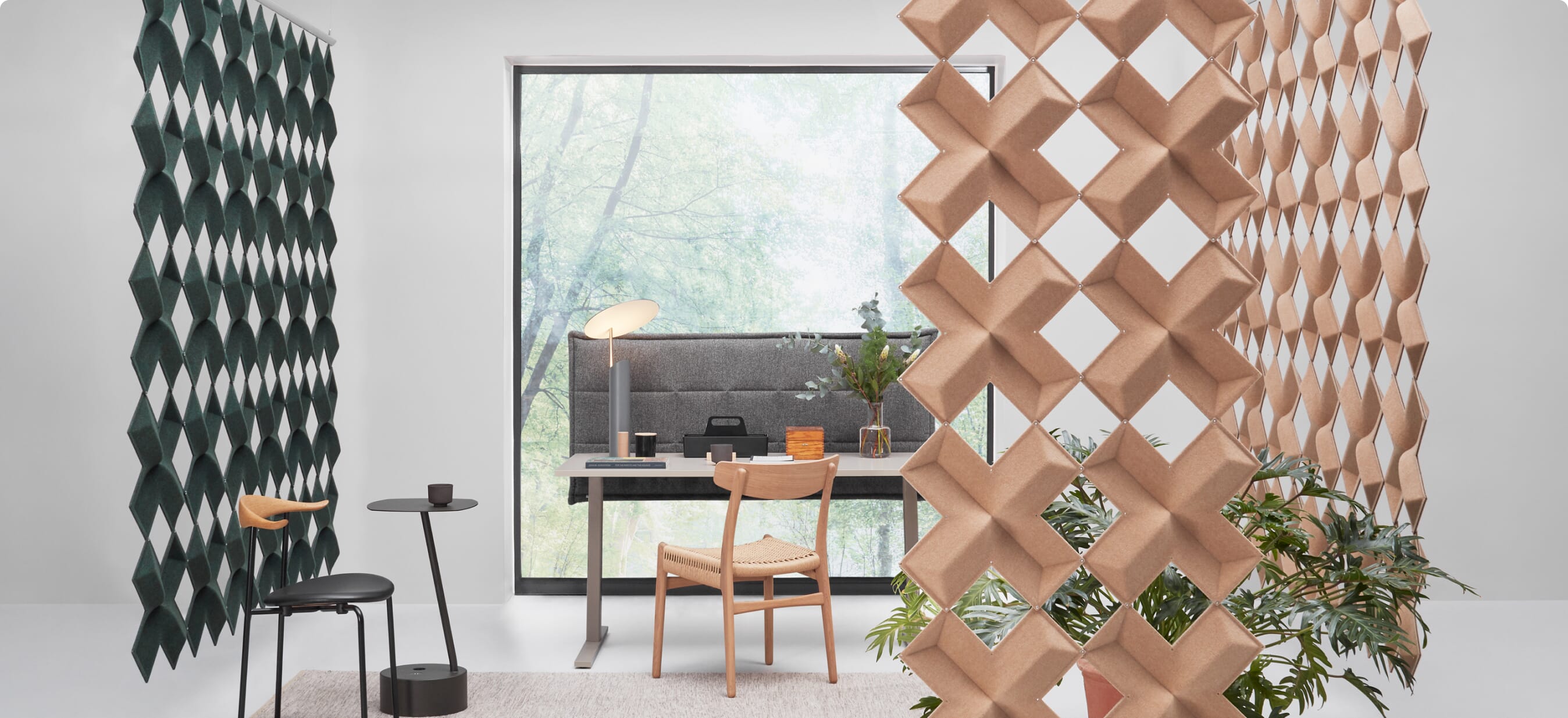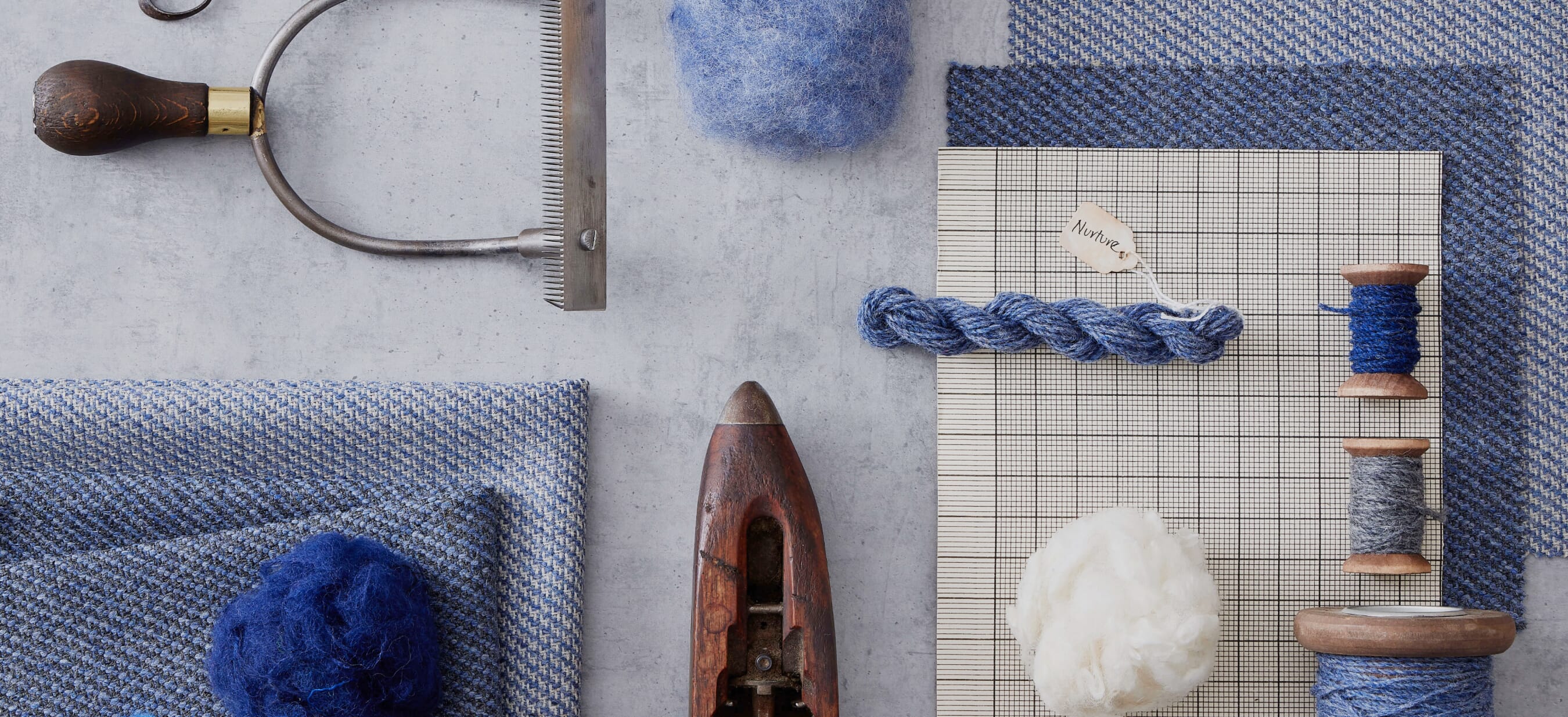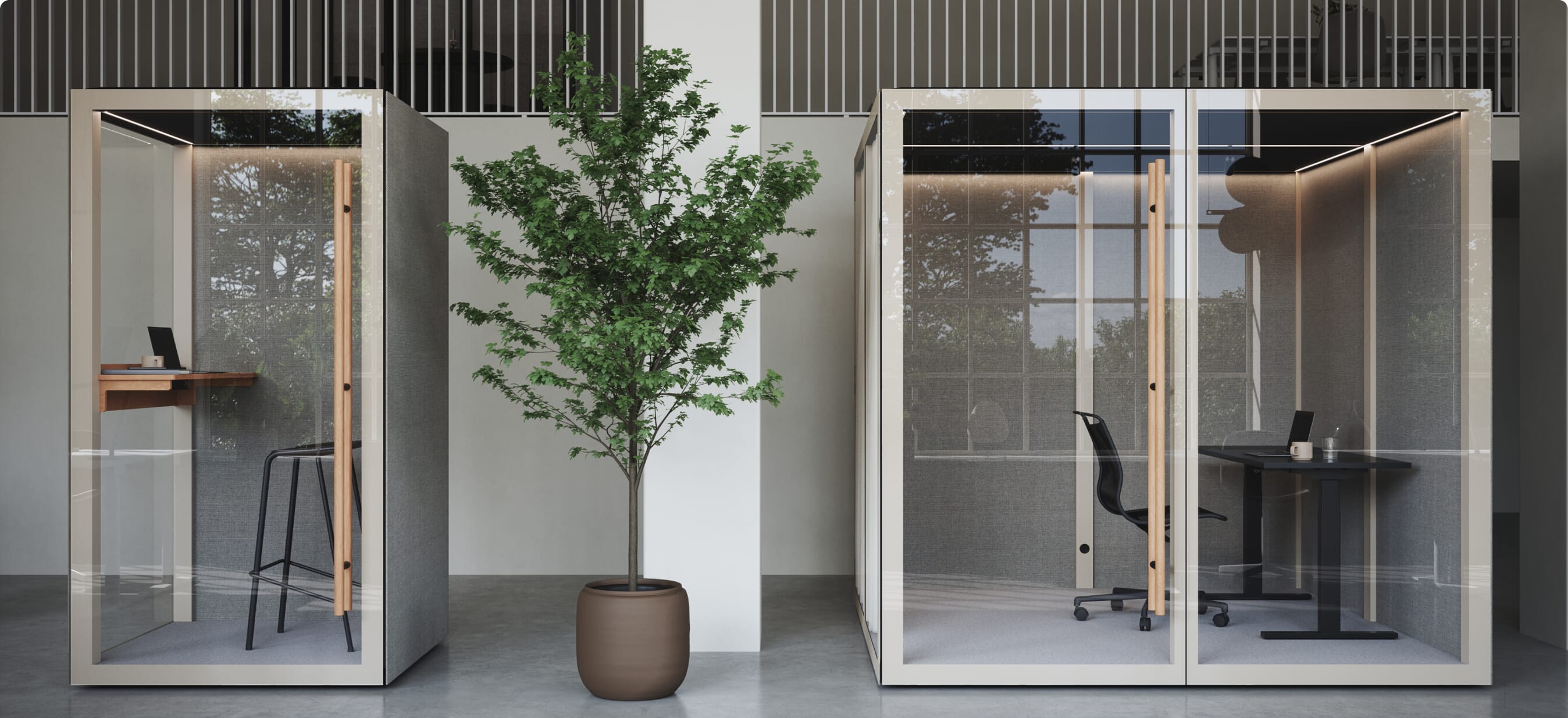Acoustics Wall & Hanging Panels Buying Guide
Acoustic wall panels are part of a growing subsection of furniture that centres around room acoustics. Believe it or not, learning about room acoustics can make a big difference to your work environment. You can use specially designed furniture to absorb sound waves and create smooth soundscapes.
Say goodbye to screeching chairs, banging doors, and loud footfalls. In this guide, you will learn everything that you need to know about acoustical wall panels in corporate environments. We will explain what acoustic wall panelling is and when and where to use it.
What Are Acoustic Wall Panels?
Acoustic wall panels are one of the most effective solutions for office spaces. True to the name, these kinds of panels are installed flush to the wall. Like other acoustic panels, they contain a sound-absorbent core that is flanked by fabric on either side.
There are all sorts of designs to choose from, including modular panels that you can rearrange to create eye-catching aesthetics. Corkbee 3D panels are brilliant for people who want to personalise and rearrange their acoustic furniture.
Sound Waves Explained
Sound waves are all around us, but what exactly are they?
Sound waves are vibrations travelling through a medium. The transmission medium can be a gas, liquid, or solid.
When sound waves encounter a solid object, such as an acoustic wall panel, they change. If the object has noise-dampening qualities, the sound wave will dissipate.
Types of Sounds
Before you purchase acoustic wall panelling, you need to know which acoustic problems you are tackling.
Echoes - Echoes are one of the biggest problems in open-plan offices. They happen when sound waves hit hard, flat surfaces and bounce back. The listener hears the sound wave hit the wall, but they also hear the sound wave that bounces back at them.
Reverberations - Reverberations are prolonged sounds, which can be just as annoying as echoes. They happen when sounds hit flat, hard surfaces and reflect again and again. The reflected sound waves dissipate over time.
Soundscapes Explained
The term "soundscape" as we know it was first coined in 1969 by then PhD student Michael Southworth in an article entitled "The Sonic Environment of Cities". Before that, Canadian composer R. Murray Schafer spoke of soundscapes in terms of contemporary music in 1967, but Southworth popularised the term in relation to architecture and urban design.
Now, when we talk about soundscapes, we are referring to the collective sounds in a given space. The size and layout of the space have a significant impact on the soundscape, as do the materials, furnishings, and people in the room. Everything has absorption qualities, not just acoustical wall panels.
Why Are Soundscapes Important?
Soundscapes are a fine balance. If your room is completely bare, the soundscape will be filled with echoes and reverberations. If your room has too many acoustic wall panels, couches, and curtains, the room will be acoustically dead. This happens when there is no reverberation, but strong attenuation.
Neither of these options is desirable, especially in communal spaces. If a lecture hall is acoustically dead, how can a speaker convey their ideas? The same principle applies to communal office spaces. To communicate clearly and effectively, office managers need to create suitable soundscapes.
There are a few other reasons why employers might need to think about their soundscapes. They have to adhere to the sound guidelines set out by the Control at Work Regulations. In accordance with these regulations, employers can only expose their employees to sounds over 85 dB if they also provide hearing protection.
Acoustics and Mental Health
In the last few decades, there has been far more concern and awareness around the mental state of office workers. Corporate employees are often subject to harsh soundscapes that include all sorts of frustrating and distracting sounds.
Noise pollution has been recognised as one of the four types of pollution, including air, water, and light pollution. One report concluded that noise pollution "interferes in complex task performance, modifies social behaviour and causes annoyance." Another study specifically looked at the impact of increased sounds in work environments and found that a 10 dB increase is related to a 1.9% decrease in physiological well-being, whereas a 10 dB decrease is related to a 5.4% increase in physiological well-being.
Of course, acoustic wall panelling can change this. But why should employers invest in mental health? Isn’t mental health a personal concern?
Actually, mental health directly influences work performance. One in six people in the UK experience mental health problems in the workplace. On top of that, employers lose 12 billion working days each year to depression and anxiety. By allowing loud, abrasive soundscapes to go unchecked, employers are allowing money to slip through their fingers.
What Are Decibels?
A decibel (dB) is a measure of sound. The human ear can hear from 0 dB to 130 dB. Decibels are based on a scale of magnitude, instead of a linear scale. 10 dB is 10 times more powerful than 0 dB.
These examples illustrate the scale of decibels in real life.
- 30 dB - Whisper
- 40 dB - Library
- 50 dB - Fridge sounds
- 60 dB - Electric toothbrush
- 70 dB - Washing machine
- 80 dB - Alarm clock
- 90 dB - Blender
- 100 dB - Snowmobile
- 110 dB - Concert 120 dB - Ambulance siren
How to Create a Smooth Soundscape
Employers are becoming increasingly aware of the ill effects of noise pollution, and they are coming up with new and innovative ways to to improve their soundscapes.
Buy acoustical wall panels. If you are struggling to get your soundscape under control, there is nothing better than buying furnishings that have sound-absorbing qualities. Acoustic wall panels are available in a number of styles and sizes, and you can even buy modular acoustic wall panelling that can be arranged to suit any space.
Invest in textiles. Textiles are excellent sound absorbers, so it is worth investing in a few couches, carpets, and rugs. Plush, porous furnishings absorb sound waves and force them to dissipate. Of course, a lot of interior designers will opt for these kinds of furnishings anyway, so it’s an easy win!
Purchase soft feet for your furniture. You can stop harsh sounds before they happen by putting soft feet on your furniture.
Create noise-cancelling booths. You can use a combination of acoustical wall panels and freestanding acoustic panels to create your very own noise-cancelling booths.
Enforce a quiet hour. Sometimes the simplest tips are the most effective. By enforcing a regular quiet hour, you can help your employees focus on important tasks.
Decorate your space. Sound waves move freely in completely empty rooms. So why don’t you give them something to crash against? Opt for tall, thin shoe racks and wide paintings to cover as much surface area as possible.
3 Important Sound Principles
Acoustic wall panels help with attenuation, diffusion, and absorption. They are three of the most important principles for people who want to tackle harsh soundscapes.
Attenuation is when sound waves travel and lose energy. As sound waves cover more distance, they become less loud. Eventually, they dissipate completely. Attenuation measures how much sound is lost over any given distance.
Diffusion tells us how sound waves spread out through space. If unobstructed, a sound wave will spread out in an expanding half-circle that moves away from the source. If a sound wave hits an object or a different material, the style of diffusion is altered.
Sound absorption is how effective a material is at absorbing sound waves. Insulation is very sound-absorbent, but cardboard has terrible noise-reducing qualities.
When Should I Use Acoustic Wall Panels?
So, when should you use acoustic wall panelling?
Interior designers who have their fingers on the pulse will recommend installing acoustic furnishings in your office before it even opens. By integrating acoustical wall panels into your workspace, you can make mental health a priority from the very beginning.
Acoustic wall panels are essential for communal environments. Libraries, community centres, schools, reception areas, and offices all over the UK use our acoustic furnishings to create soft, welcoming soundscapes.
Office workers benefit the most from acoustic furnishings. The average office worker is bombarded by loud, abrasive sounds for up to eight hours every single day. Even just a few well placed acoustic panels can make a world of difference.
How to Use Acoustic Wall Panelling
To get the most out of your acoustic wall panelling, you need to be strategic. Here are a few questions that you should ask yourself before you buy any acoustic furniture.
- Materials - What furniture is already in my room? Are my couches upholstered in noise-cancelling materials? Have I chosen effective textiles?
- Coverage - Are my walls bare? Do I need to invest in acoustical wall panels that cover the full height and breadth of my walls, or do I need to focus on one specific area?
- Context - What is going to happen in this room? Will it be used for meetings? Do I need to account for heavy footfall, or is it a private office?
- Layout - What shape is my room? Do I need to buy specific furniture to combat the shape of my room?
As you can see, room acoustics is a complicated subject. To help you along the way, we’ve put together recommendations for small rooms, open-plan offices, and meeting rooms.
How to Use Acoustical Wall Panels in Small Rooms
Small rooms present a unique set of acoustic problems. The walls are close together, so sound waves have to travel less distance to hit a flat, solid object. This creates a ping-pong effect where reverberations are more likely to happen.
To combat this problem, you can invest in acoustic panels for walls. Our acoustic panels have a soft, porous exterior and a solid sound-absorbing core. Once the panels are installed on your walls, they act as a soft, plush surface for sound waves. Waves are absorbed on the surface and dissipate throughout the panel.
Abstracta Scala Acoustic Wall Panel is one of our most advanced acoustic wall options to date. This modular wall system is made from recycled PET felt and features a curved design which creates a larger surface area to absorb more vibrations.
How to Use Acoustic Wall Panels in Open-Plan Offices
Open-plan offices are more popular than ever before. The super sleek style, high ceilings, and expansive interior might look like a magazine cover, but it is a breeding ground for harsh soundscapes. Sound waves have ample room to travel overhead and connect with hard, flat walls.
If you are battling a loud, irritating soundscape in your open-plan office, acoustic wall panelling could be the answer to your problems. Wall panels will absorb sound waves before they create harsh sounds.
We stock Evergreen Acoustic Moss Wall Panels for office managers who want to bring a pop of colour into their workspaces. This panel has 100% natural preserved moss that has been treated to be fire retardant. The naturalistic style brings the outdoors inside, which is bound to boost morale as much as the noise-reducing qualities. And it has the added bonus of being aesthetically pleasing.
How to Use Acoustical Wall Panels in Lecture Halls
Lecture halls and big meeting rooms often suffer from poor soundscapes. These rooms have vast open spaces, so sound waves have almost complete freedom of movement. The context of the rooms also means that there is a lot of chatter and background noise, which creates a massive amount of noise pollution.
The best solution is to install acoustical wall panels. You can install wall panels wherever the problem lies and, as soon as abrasive sound waves hit the surface of the panel, they will cease to exist. Using these in combination with acoustic ceiling tiles or rafts also provides additional sound absorption.
Abstracta Triline Acoustic Wall Panels are a great option for people who need to work around pre-existing installations and scant surface areas. You can install this modular panel horizontally or vertically, and even create your own symmetrical and asymmetrical designs.

Pick Our Brains
Do you want to learn about acoustic panels, screens or furnishings, for your space? Book a consultation with us today to see how you can soften your soundscape and find effective furnishings.
Contact us

